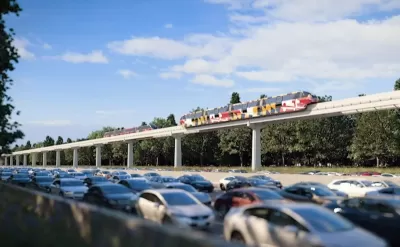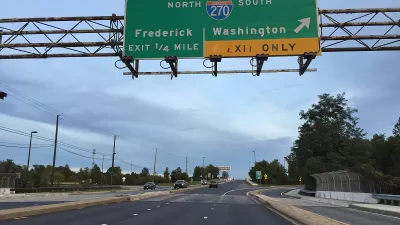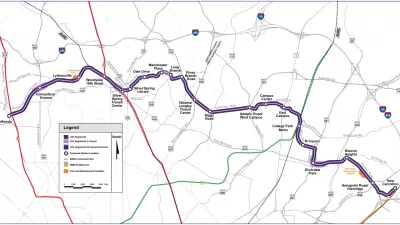A plan to widen Interstate 270 in Maryland was approved earlier this year under the condition that the state also study a plan to build a monorail along the route.

Dan Malouf writes: "Maryland will officially study a proposal to build a monorail along I-270, from Shady Grove to Frederick. Let’s examine whether that’s a crazy idea, or if monorail is a legitimate and practical possibility."
As noted by Malouf, the monorail feasibility plan is a component of a larger plan to widen I-270, approved by the Maryland Public Works Board in June 2019.
"If built, the foundation’s plan would see a 27-mile monorail, mostly along I-270, with six stops: Frederick, Urbana, Comsat (Clarksburg), Germantown, Metropolitan Grove, and Shady Grove. They say the elevated monorail would take 31 minutes to get from Frederick to Shady Grove, carry between 39,000 and 55,000 riders per day, and cost around $3.4 billion to build," explains Malouf.
Malouf digs into the strengths (e.g., lighter, cheaper, and aesthetic above ground) and weaknesses (e.g., must be elevated, can't switch tracks, potentially more expensive).
The High Road Foundation, the advocates behind the proposal, "seem most keen to provide a direct transit connection between Frederick and Montgomery County, according to Malouf, so the article also considers the potential of other modes (e.g., bus rapid transit, Metro rail, light rail, Diesel Multiple Units) to meet the need.
FULL STORY: Is a monorail on I-270 in Maryland a crazy idea? Here are its legit pros & cons

Maui's Vacation Rental Debate Turns Ugly
Verbal attacks, misinformation campaigns and fistfights plague a high-stakes debate to convert thousands of vacation rentals into long-term housing.

Planetizen Federal Action Tracker
A weekly monitor of how Trump’s orders and actions are impacting planners and planning in America.

In Urban Planning, AI Prompting Could be the New Design Thinking
Creativity has long been key to great urban design. What if we see AI as our new creative partner?

Florida Seniors Face Rising Homelessness Risk
High housing costs are pushing more seniors, many of them on a fixed income, into homelessness.

Massachusetts Budget Helps Close MBTA Budget Gap
The budget signed by Gov. Maura Healey includes $470 million in MBTA funding for the next fiscal year.

Milwaukee Launches Vision Zero Plan
Seven years after the city signed its Complete Streets Policy, the city is doubling down on its efforts to eliminate traffic deaths.
Urban Design for Planners 1: Software Tools
This six-course series explores essential urban design concepts using open source software and equips planners with the tools they need to participate fully in the urban design process.
Planning for Universal Design
Learn the tools for implementing Universal Design in planning regulations.
Gallatin County Department of Planning & Community Development
Heyer Gruel & Associates PA
JM Goldson LLC
City of Camden Redevelopment Agency
City of Astoria
Transportation Research & Education Center (TREC) at Portland State University
Jefferson Parish Government
Camden Redevelopment Agency
City of Claremont





























